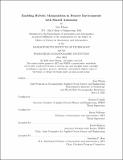Enabling Robotic Manipulation in Remote Environments with Shared Autonomy
Author(s)
Phung, Amy
DownloadThesis PDF (12.28Mb)
Advisor
Camilli, Richard
Williams, Brian
Terms of use
Metadata
Show full item recordAbstract
The evolution of robotics technology continues to facilitate exploration and scientific study in remote environments, enabling research in areas that were previously impossible to reach. Robots operating in space and marine environments encounter similar operational challenges, as both face high operational costs, bandwidth-limited conditions, and natural, unstructured environments where dynamic obstacles might be present. Within the oceanographic domain, conventional deep-sea sampling operations involve remotely operated vehicles (ROVs) equipped with robotic manipulator arms to complete dexterous tasks at depth. While effective, deep-sea ROV operations require specialized instrumentation, highly trained shipboard personnel, and large oceanographic vessels, which make deep-sea samples inaccessible to most.
This thesis presents the SHared Autonomy for Remote Collaboration (SHARC) framework, and evaluates its utility within an oceanographic context. By leveraging shared autonomy, SHARC enables shore-side operators to collaboratively carry out underwater sampling and manipulation tasks, regardless of their prior manipulator operations experience. With SHARC, operators can conduct manipulation tasks using natural language and hand gestures through a virtual reality (VR) interface. The interface provides remote operators with a contextual 3D scene understanding that is updated according to bandwidth availability.
Evaluation of the SHARC framework through controlled lab experiments indicates that SHARC’s VR interface enables novice operators to complete manipulation tasks in framerate-limited conditions (i.e., <0.5 frames per second) faster than expert pilots using the conventional topside controller. For both novice and expert users, the VR interface also increased the task completion rate and improved sampling precision. During sea trials, SHARC enabled collection of an underwater in-situ X-ray fluorescence (XRF) measurement at more than 1000 meters water depth in the Eastern Pacific with centimeter-level precision by remote scientists with no prior piloting experience. This demonstration provides compelling evidence of SHARC’s utility for conducting delicate operations in unstructured environments across bandwidth-limited communications, which holds relevance for improving operations in other sensitive domains where dexterity is required. SHARC’s ability to relax infrastructure requirements and engage novice shore-side users provides a promising avenue for democratizing access to deep-sea research.
Date issued
2023-06Department
Massachusetts Institute of Technology. Department of Aeronautics and Astronautics; Joint Program in Oceanography/Applied Ocean Science and EngineeringPublisher
Massachusetts Institute of Technology